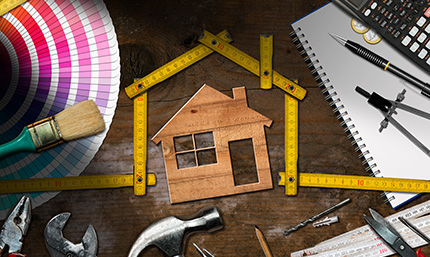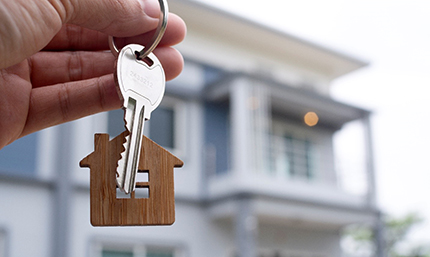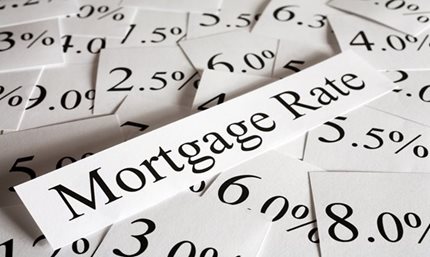News & Tips
5 Top Tips to Getting the Best HELOC Rates

Whether you’re getting your feet wet or diving in the world of loans, a HELOC is often a prime choice for borrowers. A Home Equity Line of Credit (HELOC) turns your home’s equity—the difference between the value of a home and mortgage balance—into accessible spending money you can borrow. And the crown molding on top? You can often get a lower interest rate with a HELOC than with other types of loans and credit cards.
In a nutshell, here are the 5 top tips to getting the best HELOC rates:
- Improve your credit score
- Reduce your debt-to-income ratio
- Shop around for lenders
- Build more home equity
- Opt for shorter timeframes
We’ll go over each of them in more detail. And don’t forget to give yourself “credit” for doing your due diligent research! After all, a HELOC can help you in a variety of ways from making home improvements to paying off other high-interest debts, so a good interest rate can help you save more in the long run. We at Space Coast Credit Union will give you a behind-the-scenes look to help you score the best rate.
What is the average interest on a HELOC?
Unlike many loans with fixed-interest rates, HELOC rates are variable, which means that the rates fluctuate during the term of a HELOC. A HELOC’s interest rate involves the variable prime rate and the margin. The prime rate is linked to the Federal Reserve’s federal funds rate. You can see the average interest on a HELOC and the prime rate here.
The margin is what your lender adds to the prime rate and is usually fixed throughout the term of the loan. The margin usually ranges from -1 percent to 5 percent. So, if the prime rate is 3.5 percent and the margin is +0.5 percent, your HELOC rate is 4.0 percent.
Lenders determine your margin based on a variety of factors, such as the borrower’s available equity, the amount of the loan, credit history, and the term. For borrowers with good credit, an ideal interest rate is anything between 3 and 5 percent.
Keep in mind that some lenders offer an “introductory rate,” which is a lower opening rate for a certain timeframe before raising the interest rate. For example, you may see “prime -0.5 percent for 12 months” means that your interest would be a 0.5 percent below the prime for the first year.
| Term | 12 Month Intro Rate APR* "As Low As" | Thereafter APR* "As Low As" |
|---|---|---|
| Principal-and-Interest Option 7/7 |
4.24% | 6.50% |
| Interest-Only Option 10/10 |
7.25% | 7.25% |
Special Introductory Rate valid on Principal-and-Interest HELOC for 12 months. Thereafter, the HELOC will have a Variable Rate feature as described below. Introductory rate not available on Interest-Only HELOC.
Your actual interest rate will be based on the available equity in your home, the amount of your loan, your credit history, and product chosen. Other programs, rates, and terms may be available. Approval is subject to our usual credit criteria. Proof of homeowner’s insurance sufficient to cover all outstanding mortgages, including your SCCU equity loan, and any other obligations secured by the home and property, is required. Certain restrictions may apply.
No Closing Costs (Home Equity Loans): SCCU will waive typical third-party fees associated with closing a Home Equity loan, such as appraisal, photo inspection, recording, state tax stamps, title exam, and title insurance. Must be primary residence. Available on loans up to $250,000. For Fixed-Rate Home Equity Loans (2nd Mortgages) in the first lien position, valued at $50,000 or more, waived costs do not include prepaid escrow amounts. Additional fees may apply for loans over $100K, and/or for special Deed preparation requirements.
You must already be a member of the credit union, or establish membership, which requires a one-time $5 deposit to open and maintain a regular savings account. Offers and rates subject to change at any time.
Current Prime Rate
Principal-and-Interest HELOC
As low as Prime minus 0.50% w/floor (minimum rate) and ceiling (maximum rate) of 18.00%
Term: 14 years, the first 7 years you may draw against/utilize the credit line similar to that of a credit card and are required to make a monthly payments equal to 1.5% of your outstanding balance, with a $100 minimum. During these first 7 years, like a credit card, as you pay your outstanding balance your available credit will be replenished and may be drawn against/utilized again. Your available credit equals maximum credit line minus total outstanding balance. During the final 7 years you may no longer draw against/utilize the credit line. Whatever balance remains at the end of the first 7 years must be paid in monthly installments. Required monthly payment equals 1.5% of the prior month's balance, with a $100 minimum payment. There is a possibility of a balloon payment at the end of the repayment period. Once the monthly minimum payment due is satisfied, you may choose to make additional payments toward the principal. The interest rate is still variable, thus monthly payments will vary depending on the current interest rates. However, as an option you may refinance to renew your credit line or convert to a fixed home equity loan.
Interest-Only HELOC
As low as Prime plus 0.25% w/floor (minimum rate) and ceiling (maximum rate) of 18.00%
Term: 20 years, first 10 years you may draw against/utilize the credit line similar to that of a credit card and are required to make minimum monthly payments equal to accrued monthly interest determined by the current interest rate and your outstanding balance. During these first 10 years, if you choose to pay more than your interest-only payment, thus lowering your outstanding balance like a credit card, your available credit will be replenished and may be drawn against/utilized again. Your available credit equals maximum credit line minus total outstanding balance. During the final 10 years you may no longer draw against/utilize the credit line. Whatever balance remains at the end of the first 10 years must be paid in monthly installments. Each monthly payment includes principal and interest, and equals 1.5% of the prior month's balance, with a $100 minimum payment. There is a possibility of a balloon payment at the end of the repayment period. Once the monthly minimum payment due is satisfied, you may choose to make additional payments toward the principal. The interest rate is still variable, thus monthly payments will vary depending on the current interest rates. However, as an option you may refinance your credit line or convert to a fixed home equity loan.
5 Top Tips to Getting the Best HELOC rates
To get the best HELOC rate, you’ll need to get a few things in place financially. And in most cases, you’ll need some time on your side to improve your overall figures. But don’t write yourself off if you don’t meet all of these tips perfectly—some lenders will work with you, especially if they’re eager to offer a HELOC. But if you’re looking at getting a HELOC down the road, you can get a jumpstart on building a healthier financial profile with these tips before the big application day.
Let’s take a closer look at the top tips to getting the best HELOC rates:
1. Improve your credit score
This is the most important tip because your credit score is the top factor that determines your HELOC rate. Plus, lending institutions will require that you meet a minimum credit score in order to qualify for a HELOC. They’ll look at your FICO credit score during the application process, and you’ll typically need a credit score of at least 620 or higher.
If your current credit score is less-than-stellar, you can bump it up by implementing a few different strategies:
- First and foremost, make sure you pay your minimum balances on time every month. Lenders will also look at your payment history to ensure you make payments on time. This is because lenders don’t want to take on too much of a risk by issuing money to a borrower with a history of late payments.
- Second, lower your outstanding balances as much as possible.
- Lastly, don’t close old credit cards or apply for too many new ones—especially before you apply for a HELOC, as this can hurt your score.
You can check your FICO credit score by looking at your credit reports from Experian, Equifax, and TransUnion. Check to see if there are any errors. If you see any, be sure to reach out to the bureau to dispute the error and request its removal. To keep tabs on your score, sign up for FICO Score in SCCU’s Online Banking.
2. Reduce your debt-to-income ratio
With a lower debt-to-income ratio, lenders will see that more of your money can go towards paying off your HELOC, which usually equates to lower HELOC rates. Typically, lenders will require that you have a debt-to-income ratio that doesn’t exceed 43 percent for a HELOC.
For example, let’s say your monthly debts are $1,300 for your mortgage and $500 for your auto loan. If your income is $5,000, then your debt-to-income ratio is 36 percent ($1,800 divided by $5,000). You can calculate yours with SCCU’s debt-to-income ratio checklist.
To reduce your debt-to-income faster, it’s a good idea to pay more than the minimum monthly payment. You can also consider consolidating all of your debt to get a lower interest rate and pay off the overall debt faster. On the flip side, you can talk to your current employer about your salary and see if you’re due for a raise.
3. Shop around for lenders
Whether you’re looking at banks or credit unions, every lender will have is its own HELOC products with alluring features and requirements. For example, with some HELOC products, you can make interest-only payments during the draw period.
It’s a good idea to check with your credit union or bank first to see if they’ll offer you a good deal. They usually will to keep your business, but it may not be the best rate. Different lenders will give you different quotes, so it’s best to explore your options to find a HELOC rate that will work best for you.
While it’s a good idea to shop around, keep in mind that once an institution pulls your credit to give you a quote, you only have a limited time to get quotes from other lenders without it affecting your credit score.
4. Build more home equity
When you have a substantial amount of equity, you’ll often pose less of a risk to lenders. This usually equates to a lower interest rate. Plus, more equity means a lower combined loan-to-value ratio (CLTV).
You’ll often see lenders that prefer your CLTV to be below 85 percent. You can calculate this by dividing your total mortgage loan balance plus the desired line of credit into the current value of your home.
Example: Let’s say you owe $150,000 on your home, and you desire $30,000 for your line of credit. Your home appraises for $250,000. So, to calculate the CLTV:
($150,000 + $30,000) ÷ $250,000 = .72
So, your CLTV is 72 percent, and you’d meet the requirement. If you don’t meet the required CLTV, paying additional amounts toward your mortgage principal every month will help you build home equity faster. You can calculate other costs associated with home equity loans here.
5. Opt for shorter timeframes
HELOCs with shorter draw and repayment periods often equate to lower interest rates because a shorter term usually isn’t as risky for the lender. Plus, you’ll most likely pay less interest overall equaling savings over the life of the loan. Talk to your bank or credit union about how flexible they are with letting you choose shorter timeframes for a lower interest rate.
Additional things to keep in mind:
Rate caps: If you’re concerned about HELOC rates fluctuating too much, ask your lender if they offer rate caps. This ensures that you won’t go over that maximum limit and that you won’t be hit hard if the prime rate increases more than expected over a short timeframe.
Hidden fees and closing costs: Some lenders will charge you up-front fees, annual fees, and inactivity fees. They may even penalize you if you don’t draw a minimum amount in a certain timeframe. Also, some HELOCs charge closing costs, which are third-party fees for things like a photo inspection, title insurance, title exam, and an appraisal. Luckily, SCCU waives closing costs on most home equity loans. For some, cash-out refinancing may be a more suitable option as well.
Balloon payments: Low interest rates are important, but keep in mind that some HELOCs may come with balloon payments. This means you’ll have to pay off the remaining balance as a lump sum at the end of your HELOC repayment period. See if your lender requires balloon payments or not.
Is a HELOC tax deductible?
The interest on a HELOC is tax deductible if it meets certain conditions, which went into effect with the 2017 tax law change.
Usually, the interest on home equity debt is tax-deductible if:
- the borrower uses the funds for home renovations,
- the money goes toward renovating the property whose equity is the source of the loan, and
- interest is deducted up to a limit of $750,000 of residential loans.
You should consult your tax advisor to ensure you get the maximum deductions while meeting all of the specific requirements.
What’s an interest-only HELOC?
An interest-only HELOC means that you’re only required to make monthly payments equal to the accrued monthly interest during the draw period. If you pay more than your minimum interest-only payment during the draw period, your available credit will be replenished (the difference between your maximum credit line and the outstanding balance).
An interest-only HELOC may be the right option for you if you’d like to make smaller payments during the initial period, and you’re confident you can make larger payments during the repayment period. This is also a more flexible option for those with variable incomes. You can make smaller payments when your income’s low and make larger payments (or save for the repayment period) when your income’s more lucrative.
What is the process to obtain a HELOC?
At SCCU, we’ll help you through the process step by step. First, we’d like to know more information about your property and how much you’d like to borrow. Then, we ask for specific documents for verification, such as evidence of income, mortgage statements, and identification cards. After approval, we’ll help you get everything in place to set up your line of credit. We offer competitive HELOC rates, and one of our Team Members would be more than happy to answer any questions you have about them. Feel free to contact us.
































